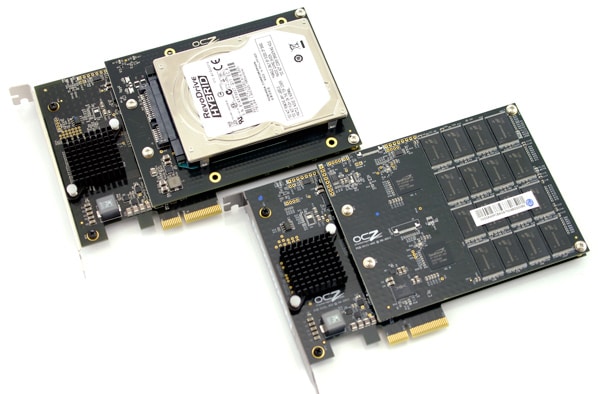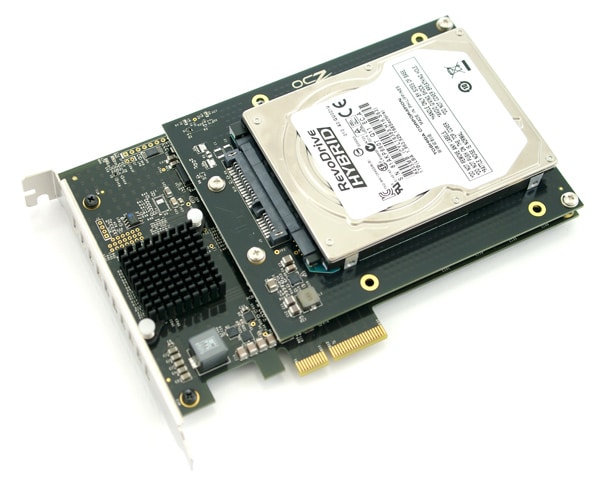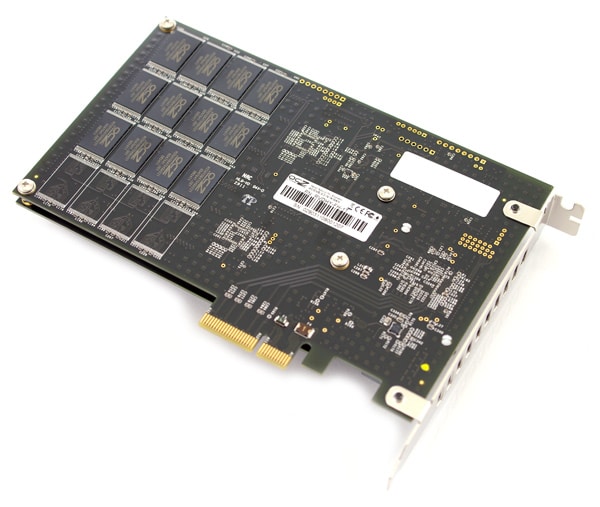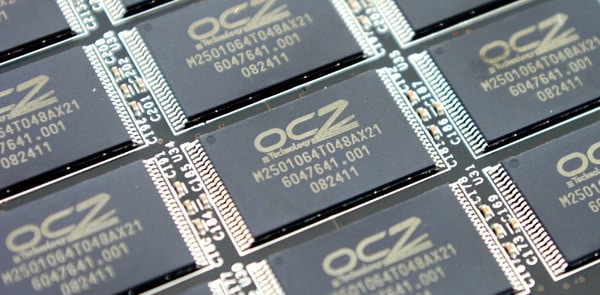
OCZ recently announced availability of the 1TB RevoDrive Hybrid, which marries a 1TB 2.5" hard drive with a 100GB OCZ SSD and caching software to deliver SSD like speeds across the larger storage volume. The hybrid idea of course isn’t new, Seagate’s Momentus XT has shipped over one million units and there are several client and enterprise solutions that use a combination of hardware and software to accomplish similar goals. OCZ’s going for simplicity though, a self-contained solution that is easy to set up and leverages the PCIe interface to deliver reads up to 910 MB/s, writes of 810 MB/s and 4KB random write IOPS of 120,000.
While the thought of a hybrid SSD and hard drive solution may conjure up thoughts of slapping together a Vertex 3 and 1TB notebook drive onto a PCIe card; the solution is substantially more elegant. The RevoDrive Hybrid is actually more like the RevoDrive 3 X2 we recently reviewed; though the Hybrid has two SandForce SF-2281 processors compared to four, and less NAND. The point is, the RevoDrive Hybrid is a performance car, with minivan capacity.

As it stands, the RevoDrive Hybrid is available in a single 1TB capacity. The 2.5" hard drive can be removed though, meaning the drive capacity could be upgraded as manufacturers release higher capacity 2.5" drives – however this does require BIOS support from OCZ. The MSRP is $499, which if measured on a combined performance and capacity scale, is actually pretty favorable. 1TB of SSD storage is going to run into the $2500+ area, a 1TB 2.5" hard drive is roughly $100.
The value proposition is pretty clear, the likelihood of success though resides firmly on OCZ’s ability to integrate the Dataplex caching software from NVELO to deliver the heady performance enthusiasts expect.
OCZ RevoDrive Hybrid Specs
- Usable Capacities (IDEMA) – 100GB SSD+1TB HDD
- 25nm MLC NAND
- PCI-Express Gen. 2 x4
- PCIe FullHeight
- SandForce SF-2281 x 2
- Hard Drive Rotational Speed – 5,400 RPM
- Dataplex Caching Software
- Size: 167.64 x 98.42 x 22.15 mm (dimensions do not include bracket)
- Weight: 289g
- Power Consumption – Idle: 8.1W Active: 10W
- MTBF – 600,000 hours
- Read unrecoverable bit error rate (UBER) 10e-16 (<1in 1016 bits read)
- 128-bit & 256-bit AES-compliant
- 3-Year Warranty
Design and Build
The OCZ RevoDrive Hybrid is built on the same platform as the RevoDrive3 X2 we reviewed earlier this year, with the main difference being the daughter board has a hard drive installed on it versus another half of an SSD. The base section of the card still includes two SandForce SF-2200 controllers, with MLC NAND split up between both.
The card offers sixteen OCZ branded NAND pieces with a capacity of 16GB each. This gives the card a raw capacity of 128GB with 100GB visible by the end-user. This level of over-provisioning is more aggressive than what is usually found in consumer products, but aligns with what you might find in an enterprise setting. Since the NAND is seeing more write cycles in a hybrid setting over a standard boot drive, it needs to cope with more wear over its lifespan.
Caching System
The OCZ RevoDrive Hybrid has a unique caching system unlike what we saw in place on other hybrid platforms such as the Seagate Momentus XT. On the XT, all the user saw from the hardware level was a single 500GB hard drive, with the internal software hiding the 4GB SLC NAND from the outside. The software then picked up on what data was being used frequently and cached accordingly. On the OCZ hybrid solution the user sees both the SSD and HDD hardware devices from the start, with software installed to handle caching. This presents a few problems, although most are related to benchmarking, not the standard user experience.
From a consistent benchmarking perspective, we work with raw unpartitioned drives, with the drive being tested always being secondary. This leaves out any I/O interaction with the drive during tests and removes the software layer from slowing down or skewing results between runs. The OCZ caching solution needing an OS to be installed to function puts our standard benchmarking processes in a bind, pushing us from IOMeter to higher-level system benchmarks such as PCMark Vantage to show the differences in performance.
First Thoughts Wrap-up
We’re diligently running the RevoDrive Hybrid through our testing methodology now and will post a full review with detailed benchmarks soon. Please post any questions or comments for the full review in our forums.
Update – OCZ RevoDrive Hybrid Review Posted
Discuss This First Thoughts Review



